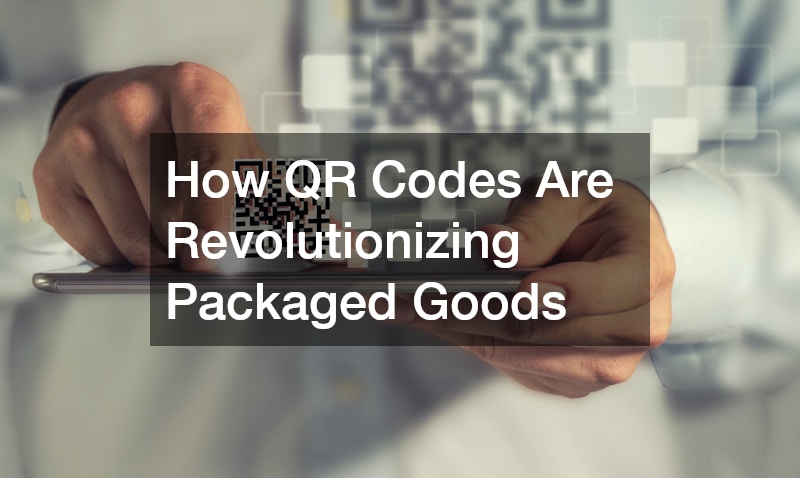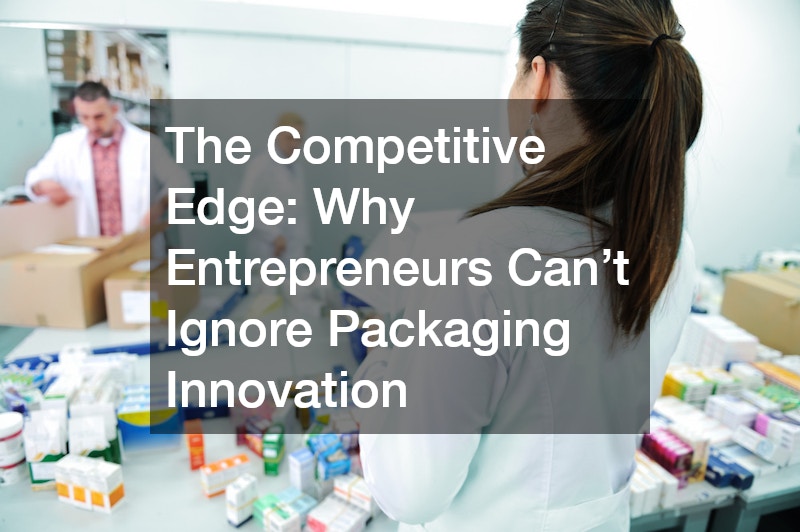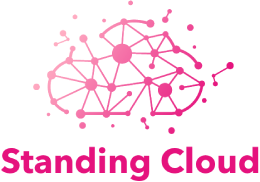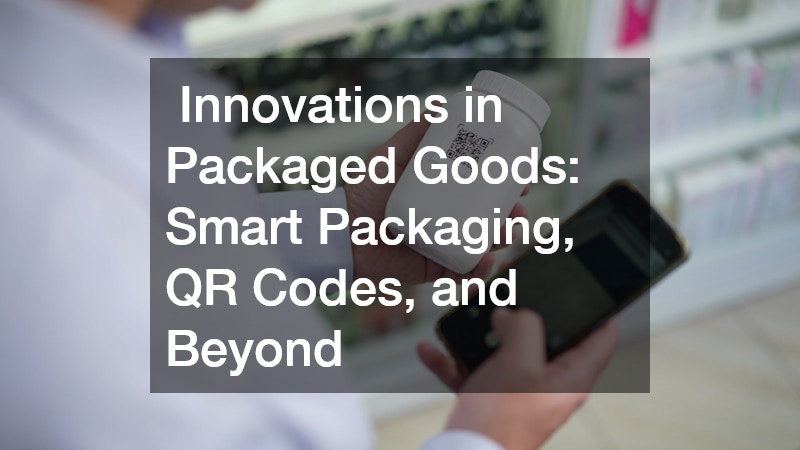The packaged goods industry is undergoing a major transformation, fueled by advancements in technology and shifting consumer expectations. From smart packaging that tracks freshness to QR codes offering detailed product stories, the modern packaging landscape is now a key player in product marketing, logistics, and customer experience. For entrepreneurs, these innovations represent not just a trend but a strategic opportunity.
Whether you’re launching a food product, a cosmetic line, or a household item, staying ahead of packaging innovations can significantly elevate your brand, improve customer trust, and streamline your operations. This article explores the most exciting developments in the world of packaged goods and offers practical insights into how entrepreneurs can leverage them to succeed.
- What Is Smart Packaging and Why Should Entrepreneurs Care?
- How QR Codes Are Revolutionizing Packaged Goods
- The Role of IoT and Connected Packaging in Business Strategy
- How Sustainable Innovations Are Reshaping Packaged Goods
- Augmented Reality (AR) and the Future of Interactive Packaging
- Using Smart Packaging to Improve Supply Chain Efficiency
- Innovations in Packaged Goods Startups You Can Adopt Today
- The Competitive Edge: Why Entrepreneurs Can’t Ignore Packaging Innovation
- How Consumer Expectations Are Driving Innovation in Packaged Goods
- Conclusion
What Is Smart Packaging and Why Should Entrepreneurs Care?
Smart packaging refers to advanced packaging systems that go beyond the traditional role of protecting and displaying a product. These systems can monitor, detect, communicate, and even respond to environmental conditions or consumer interactions.
Smart packaging is typically categorized into two types:
- Active Packaging: Alters the condition of the packaged product to extend shelf life or improve safety (e.g., oxygen scavengers or moisture absorbers).
- Intelligent Packaging: Uses sensors, indicators, and digital interfaces to monitor the condition of the product and provide information to the consumer or producer.
Why it matters:
For entrepreneurs, smart packaging offers numerous benefits:
- Brand Differentiation: Stand out in a crowded market with high-tech, interactive packaging.
- Supply Chain Transparency: Track products in real-time, improving inventory control and traceability.
- Improved Consumer Engagement: Deliver interactive experiences directly through the packaging.
With the rising demand for product transparency and convenience, smart packaging is rapidly becoming a necessity, not a luxury.
How QR Codes Are Revolutionizing Packaged Goods

Quick Response (QR) codes are simple yet powerful tools that are changing how brands communicate with consumers. By scanning a QR code on a product package, customers can instantly access a wide range of content—from ingredients and sourcing information to user guides, promotional videos, and loyalty programs.
Benefits of QR codes in packaged goods:
- Enhanced Transparency: Allow consumers to verify product authenticity and learn about sourcing and sustainability.
- Real-Time Engagement: Link to time-sensitive promotions or personalized content.
- Data Collection: Track user interactions and measure consumer behavior through QR code usage analytics.
- Cost-Effective: Easy to implement with minimal investment in physical infrastructure.
Examples of usage:
- Food Products: Direct consumers to digital recipes, allergen info, or farm-to-table traceability.
- Beauty & Skincare: Link to how-to-use videos or detailed ingredient descriptions.
- Household Items: Offer downloadable manuals or safety information.
Entrepreneurs can use QR codes to bridge the gap between physical products and the digital brand experience, creating an immersive customer journey that boosts engagement and loyalty.
The Role of IoT and Connected Packaging in Business Strategy
The Internet of Things (IoT) is now finding its way into the packaging world, enabling “connected packaging” that communicates with other smart devices. This trend opens up countless opportunities for both consumers and businesses.
What is connected packaging?
Connected packaging uses embedded sensors, RFID tags, and communication technology (such as Bluetooth or NFC) to connect products to the internet or a network, offering real-time data and interaction.
Business advantages for entrepreneurs:
- Inventory Management: Monitor product location and shelf conditions in real time.
- Quality Control: Track temperature, humidity, or movement to ensure product integrity, especially in perishables.
- Consumer Insights: Analyze how, when, and where customers interact with the packaging.
- Personalization: Deliver targeted offers and updates via connected apps.
Case in point:
A startup beverage brand could use connected caps that track bottle openings and usage patterns, rewarding frequent buyers or sending push notifications with product tips.
For entrepreneurs, connected packaging means smarter decisions, greater transparency, and a deeper understanding of customer behavior.
How Sustainable Innovations Are Reshaping Packaged Goods
Environmental concerns are pushing the packaged goods industry to rethink its approach. Consumers are more eco-conscious than ever, demanding sustainable, recyclable, and biodegradable packaging solutions.
Key sustainability innovations:
- Biodegradable Films: Packaging that decomposes naturally, reducing environmental impact.
- Plant-Based Plastics: Made from renewable resources like corn or sugarcane.
- Edible Packaging: Especially in food products, where the wrapper itself is safe to consume.
- Minimalist Design: Reducing material usage without sacrificing protection or aesthetics.
Why this matters to entrepreneurs:
- Customer Preference: Studies show consumers are more likely to buy from brands with sustainable practices.
- Compliance: Governments are tightening regulations on plastic use and waste management.
- Brand Trust: Eco-friendly packaging enhances brand reputation and consumer loyalty.
Entrepreneurs who embrace sustainable packaging not only contribute to environmental protection but also align with modern consumer values, giving them a competitive edge.
Augmented Reality (AR) and the Future of Interactive Packaging
One of the most exciting frontiers in packaging innovation is the integration of augmented reality (AR). With AR, packaging becomes a dynamic portal into the brand world, offering immersive experiences that boost engagement and retention.
What AR packaging can do:
- Interactive Instructions: Show customers how to use a product step-by-step through animations.
- Gamified Promotions: Let users scan packaging to play branded mini-games or unlock discounts.
- Virtual Try-Ons: Particularly useful for cosmetics and apparel packaged items.
Benefits to entrepreneurs:
- Increased Brand Engagement: AR content keeps users interacting longer.
- Storytelling Potential: Share your brand story in a rich, visual format.
- Data & Metrics: Track user engagement and tailor content accordingly.
Even without in-house developers, entrepreneurs can partner with AR providers to launch campaigns quickly. The investment often pays off through viral sharing, higher brand awareness, and customer retention.
Using Smart Packaging to Improve Supply Chain Efficiency
Beyond marketing and consumer interaction, smart packaging is also transforming the logistics and supply chain side of packaged goods businesses.
How smart packaging streamlines operations:
- Real-Time Tracking: GPS and RFID tags help businesses monitor shipment status and inventory.
- Condition Monitoring: Sensors track temperature and humidity during transit, crucial for perishables or sensitive items.
- Tamper Detection: Smart seals alert suppliers and consumers if a package has been opened or altered.
Benefits to entrepreneurs:
- Reduced Waste: Monitor shelf life and storage conditions to reduce spoilage or product returns.
- Improved Forecasting: Use data to predict trends, restocking needs, and seasonal demand.
- Faster Recalls: Isolate problem batches quickly with traceable packaging systems.
For entrepreneurs dealing with physical goods, integrating smart packaging into your logistics strategy can result in better efficiency, customer satisfaction, and cost savings.
Innovations in Packaged Goods Startups You Can Adopt Today
You don’t need a massive budget to start integrating modern packaging innovations into your startup. Here are some accessible ideas:
1. Start with Smart Labels
- Use QR codes linked to digital content.
- NFC stickers that launch your mobile app.
2. Outsource Smart Features
- Work with third-party providers that offer connected packaging as a service.
3. Focus on Sustainability
- Choose recyclable or biodegradable packaging partners.
- Highlight your eco-practices in marketing materials.
4. Incorporate AR Content
- Partner with AR design agencies for launch campaigns.
- Create an interactive experience to generate buzz.
5. Use Analytics to Evolve
- Track how users interact with digital packaging features.
- Adjust content, promos, or features based on data insights.
These simple yet impactful steps can immediately increase the perceived value of your product while setting the stage for more advanced innovation down the line.
The Competitive Edge: Why Entrepreneurs Can’t Ignore Packaging Innovation

In a market where product quality is just one piece of the puzzle, packaging innovation has emerged as a key differentiator. For startups and small businesses, it’s an opportunity to:
- Compete with bigger brands by creating memorable customer experiences.
- Build brand loyalty through transparency, personalization, and engagement.
- Reduce costs and increase efficiency across the supply chain.
Investing in smart, connected, and sustainable packaging is no longer optional—it’s a growth strategy. Entrepreneurs who seize this opportunity early will not only win more customers but also gain the agility to adapt quickly in a rapidly evolving market.
How Consumer Expectations Are Driving Innovation in Packaged Goods
Modern consumers expect more from the products they purchase, and packaging plays a crucial role in meeting those expectations. It’s not just about aesthetics anymore; customers demand functionality, sustainability, interactivity, and transparency. This shift is pushing brands to adopt innovative packaging solutions that align with evolving preferences.
Key consumer-driven packaging demands include:
- Sustainability: Biodegradable or recyclable packaging is now a major purchasing factor.
- Convenience: Easy-open seals, resealable containers, and portion control features are valued.
- Transparency: Access to sourcing information, ingredient details, and ethical practices through digital links.
- Personalization: Custom messages or packaging that respond to consumer data and preferences.
- Interactivity: Features like QR codes, AR content, or mobile app integration to deepen engagement.
Entrepreneurs must understand these consumer priorities to remain competitive. By aligning packaging innovations with customer values, startups can build trust, strengthen brand loyalty, and enhance the overall user experience, turning packaging into a strategic growth tool.
Conclusion
Packaging is no longer just a wrapper—it’s a powerful tool that shapes perception, drives engagement, and unlocks business intelligence. From QR codes that educate and connect to smart sensors that track freshness and movement, innovations in packaged goods are giving entrepreneurs new ways to stand out and succeed.
Whether you’re a startup launching your first product or an established small business looking to modernize, embracing packaging innovation is one of the smartest moves you can make. Not only will it resonate with today’s tech-savvy and environmentally-conscious consumers, but it will also set your business up for long-term success in a competitive marketplace.



